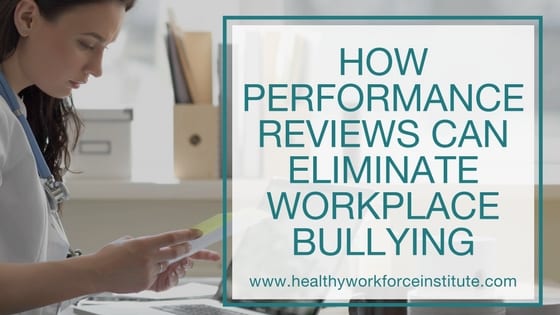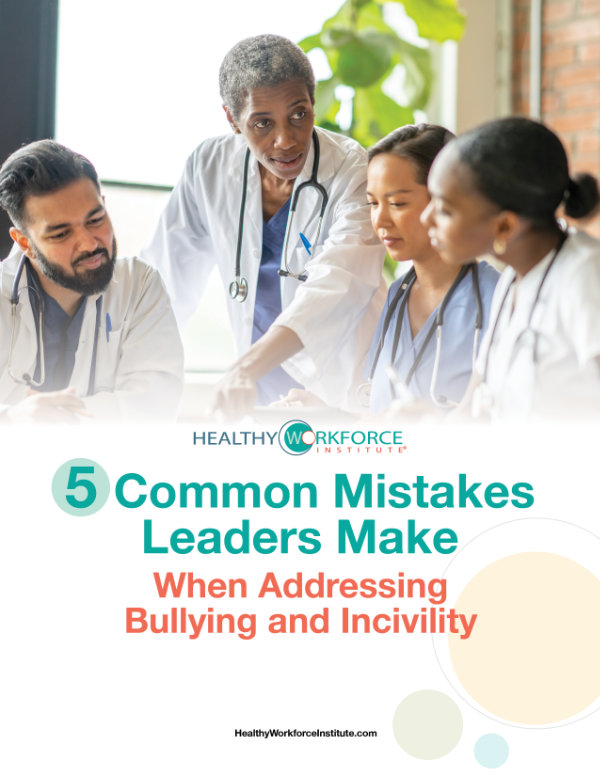 Do performance reviews come to mind when you think about the workplace bullying epidemic we have in healthcare? Of course not, but they should!
Do performance reviews come to mind when you think about the workplace bullying epidemic we have in healthcare? Of course not, but they should!
I’ve talked with thousands of nurse leaders over the years about their attempts to set behavioral expectations and hold their employees accountable. At least 75% bring up a significant barrier or brick wall. The brick wall, according to the leaders, is Human Resources.
The leaders tell me that when they FINALLY decide to terminate an employee because of their disruptive behaviors they can’t get approval from HR. When they go to their HR business partner they’re told that they don’t have enough evidence to support a termination. “Well, did you counsel this employee? Wait a minute, I see that you didn’t cross that “t” or dot that “i”….” On and on.
However, it’s not always HR’s fault.
I’ve talked with a lot of HR business partners and learned that what you think is a brick wall, isn’t necessarily put there by them. It’s built, brick by brick by the leader who doesn’t build a compelling case.
HR shares that leaders frequently request approval to terminate an employee yet they don’t have any documentation, the HR business partner has never heard about the employee as being a problem AND…here is the biggest brick – the employee has met or exceeded expectations on their last 27 performance reviews!!!
A 2016 survey conducted by Weber Shandwick revealed 87% of employees reported that workplace incivility had an impact on their work performance. 55% said their morale suffered while 45% expressed a desire to quit. Make no mistake about it, unaddressed bullying and incivility has a negative impact on retention, morale, the budget, and patient care.
Leaders need to do a better job addressing disruptive behaviors so that we can stop the hemorrhage of really great healthcare employees.
Why haven’t we gotten this right yet?
- We only give feedback once a year
According to a study conducted by PwC (a consulting firm), 60% of respondents reported wanting feedback daily or weekly. Keep in mind that this number increases to 72% with employees under the age of 30! Despite the studies that show the importance of ongoing feedback, most managers rely on the annual performance review as their forced opportunity to talk with employees about their behavior and performance.
- We are uncomfortable saying anything negative
It’s so much easier to give positive feedback but I really don’t know anyone who LOVES to give negative feedback. So we avoid it. Instead of confronting disruptive employees, we secretly hope they quit or transfer to another unit before you have to do their evaluation next year.
- The toxic employee is usually clinically competent
In many cases, the disruptive employee is clinically competent; actually, they tend to be your MOST clinically competent nurse. It is so much harder to address a competent nurse’s behavior, so we rationalize, justify, and ignore their bad behavior.
- Leaders aren’t skilled in how to communicate behavioral expectations
Nobody is teaching leaders the skills they need to engage in uncomfortable conversations with their employees. It’s rare that I find an organization that equips their front line leaders with initial and ongoing education and training regarding how to set behavioral expectations and hold their people accountable.
As a result, leaders fail to build a case compelling enough for their HR business partner to approve a termination and then claim to hit the HR brick wall. The good news is that the brick wall can be easily broken down.
Leaders need to build a case if they want to hold an employee accountable for their behavior and a critical component is the PERFORMANCE REVIEW. However, one reason why we don’t capture the essence of an employee’s badness on the performance review is because we are not prepared. Your ability to clearly capture an employee’s disruptive behavior on their performance review starts with 3 basic steps.
3 steps to prepare and produce a performance review that builds a compelling case
1. Build a relationship with your Human Resource representative
The Human Resource department plays an integral role in supporting a healthy workforce. However, it’s rare to find an organization that fosters building relationships between their HR and healthcare leaders. Schedule a meeting with your HR business partner. Talk about your intent to cultivate a healthy workforce and that you need their help to make sure you are documenting ongoing feedback (see below) and completing the performance evaluation in a way that serves to accurately reflect behavior (good, bad, or ugly). View your HR business partner as an extension of yourself.
2. Give feedback often – not just once a year
Why oh why do we succumb to the annual evaluation trap when we KNOW we should be giving ongoing feedback to our employees?
When I work with leaders to cultivate a healthy workforce by addressing workplace bullying and incivility, one of our first strategies is to engage in one-on-one conversations with employees once a month.
Yes – once a month! Don’t panic, I make it easy! “Here is what you are doing well (be specific) and here is something I want you to work on (be specific).” Then you document this conversation. It can take you a total of 10 minutes. The reason this works is that when it comes time for the employee’s performance review, you already have the content you need to populate the sections pertaining to behavior. Walla!
3. Build a case using ongoing documentation leading up to the performance review
Gather any and all documentation about behaviors throughout the year. It doesn’t matter if this documentation is anonymous, has a signature, is something verbalized to you, etc.
Gather ALL EVIDENCE. Because what you’re doing is building a case. Just like a jury, they make decisions based on the preponderance of evidence. Review all of that evidence before you complete their performance review. Pull out any objective behaviors and counseling’s you’ve provided and be sure to include the outcomes in their review.
Nurse leaders and HR representatives are on the same team; we want the same things – for employees to bring their best selves to work every day. It’s time that we SEE ourselves as partners and support each other to make sure we are all doing our part to stop the cycle of bullying and incivility in healthcare!
Be kind. Take care. Stay connected.
Helping you cultivate a healthy happy workforce,














1 thought on “How Performance Reviews Can Eliminate Workplace Bullying”
5